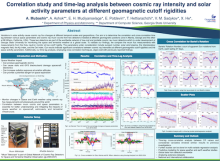Correlation study and time-lag analysis between cosmic ray intensity and solar activity parameters at different geomagnetic cutoff rigidities
Arfa
Mubashir
Georgia State University
Poster
Variations in solar activity cause cosmic ray flux changes at different temporal scales and geopositions. Our aim is to determine the correlation and cross-correlation time lag between various space parameters and cosmic ray muon counts from two detectors installed at different geomagnetic positions (one in Atlanta, Georgia and the other at Mt Wilson, California, USA). These two detectors are part of the worldwide network of low-cost and portable cosmic ray muon detectors which is under development at Georgia State University for monitoring the space and terrestrial weather at a global scale. To validate our findings, we compare the muon flux measurements with measurements from the Oulu neutron monitor at low cutoff rigidity. The parameters under consideration include sunspot number, solar wind plasma, the Bz component of the interplanetary magnetic field, the Kp index, and the Dst index. Our results indicate significant correlations between cosmic ray intensities at different geomagnetic cutoff rigidities and the space activity parameters. Additionally, our time-lag analysis, employing cross-correlation techniques, aligns well with previously reported findings.

Poster PDF
Poster category
Geospace/Magnetosphere Research and Applications
Poster session day
Poster location
16
Meeting homepage